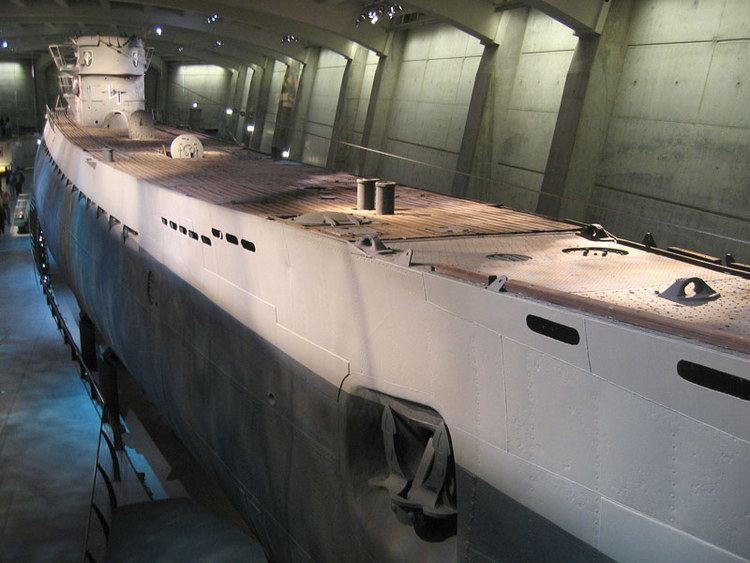Name U-160 Yard number 1010 Commissioned 16 October 1941 Construction started 21 November 1940 Length 77 m Draft 4.7 m | Ordered 23 December 1939 Laid down 21 November 1940 Fate Sunk on 14 July 1943 Launched 12 July 1941 Beam 6.76 m | |
 | ||
Part of | ||
German submarine U-160 was a Type IXC U-boat of Nazi Germany's Kriegsmarine built for service during World War II. The keel for this boat was laid down on 21 November 1940 at the DeSchiMAG AG Weser yard in Bremen, Germany as yard number 1010. She was launched on 12 July 1941 and commissioned on 16 October under the command of Kapitänleutnant Georg Lassen (Knight's Cross).
Contents
The U-boat's service began in training with the 4th U-boat Flotilla. She lost seven men and one was injured in a fire on 14 December 1941 at Danzig (now Gdańsk, Poland). She then moved to the 10th flotilla on 1 March 1942 for operations.
She sank 26 ships, totalling 156,082 gross register tons (GRT) and damaged five more, for 34,419 tons. She was sunk by American carrier-borne aircraft in July 1943.
Design
German Type IXC submarines were slightly larger than the original Type IXBs. U-160 had a displacement of 1,120 tonnes (1,100 long tons) when at the surface and 1,232 tonnes (1,213 long tons) while submerged. The U-boat had a total length of 76.76 m (251 ft 10 in), a pressure hull length of 58.75 m (192 ft 9 in), a beam of 6.76 m (22 ft 2 in), a height of 9.60 m (31 ft 6 in), and a draught of 4.70 m (15 ft 5 in). The submarine was powered by two MAN M 9 V 40/46 supercharged four-stroke, nine-cylinder diesel engines producing a total of 4,400 metric horsepower (3,240 kW; 4,340 shp) for use while surfaced, two Siemens-Schuckert 2 GU 345/34 double-acting electric motors producing a total of 1,000 metric horsepower (740 kW; 990 shp) for use while submerged. She had two shafts and two 1.92 m (6 ft) propellers. The boat was capable of operating at depths of up to 230 metres (750 ft).
The submarine had a maximum surface speed of 18.3 knots (33.9 km/h; 21.1 mph) and a maximum submerged speed of 7.3 knots (13.5 km/h; 8.4 mph). When submerged, the boat could operate for 63 nautical miles (117 km; 72 mi) at 4 knots (7.4 km/h; 4.6 mph); when surfaced, she could travel 13,450 nautical miles (24,910 km; 15,480 mi) at 10 knots (19 km/h; 12 mph). U-160 was fitted with six 53.3 cm (21 in) torpedo tubes (four fitted at the bow and two at the stern), 22 torpedoes, one 10.5 cm (4.13 in) SK C/32 naval gun, 180 rounds, and a 3.7 cm (1.5 in) as well as a 2 cm (0.79 in) anti-aircraft gun. The boat had a complement of forty-eight.
Service history
Before starting on her first patrol, U-160 made a brief journey from Wilhelmshaven to Helgoland on 24 February 1942.
1st and 2nd patrols
She departed the German island on 1 March 1942, crossed the North Sea entered the Atlantic Ocean via the Faroe / Shetland gap and headed for the US east coast. Her first victim was Equipoise, sunk on 27 March 1942 60 nautical miles (110 km; 69 mi) southeast of Cape Henry, Virginia. The confusion of the sinking was not helped by there being nationals from at least ten countries among the crew. The boat went on to successfully attack City of New York, Rio Blanco and Ulysses. One ship that did not sink was Bidwell; indeed, she survived the war, not being broken up until 1965.
U-160's second foray saw the boat leave Lorient on 20 June 1942. She crossed the Atlantic again but made for the northern coast of South America. The pickings were just as rich here as they had been further north. Sinking Beaconlight, Carmona and theTreminnard, who were all sailing without an escort, was accomplished within 200 nmi (370 km; 230 mi) of Trinidad. She also damaged Thorshavet, an 11,000 tonner, with torpedo and gun on 4 August 1942. The drifting wreck was subsequently sunk by the Italian submarine Enrico Tazzoli on 6 August. U-160 returned to Lorient on the 24th.
3rd patrol
It was during her third patrol that the boat almost came to grief. She was attacked by the escorts of a convoy on 16 October 1942.; but the damage was slight. The submarine returned to her former hunting grounds off South America and sank Gypsum Express and Leda to name but two.
4th patrol
Her fourth sortie was her longest, at 125 days, but also her most successful. Moving into the south Atlantic, she sank Roger B. Taney on 8 February. She then attacked and sank Nipura, Empire Mahseer and Marietta E. east of South Africa. Also lost with Marietta E. were eight landing craft. Other ships were also sunk. When the submariners questioned the survivors of Aelbryn, they misunderstood the ship's name, reporting it as Arian, an American vessel.
5th patrol and loss
By now she was based in Bordeaux, from which she departed on 29 June 1943. She was sunk by TBM Avenger and F4F Wildcat aircraft from the carrier USS Santee south of the Azores on 14 July 1943.
